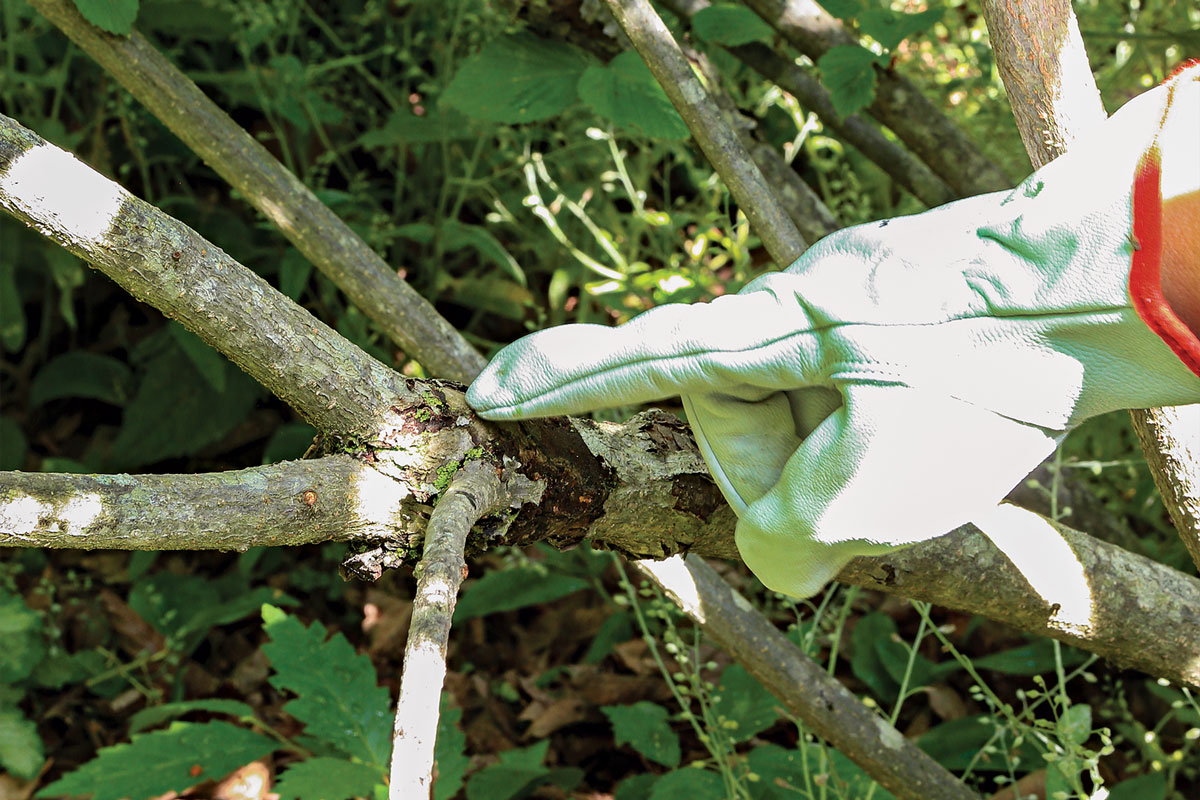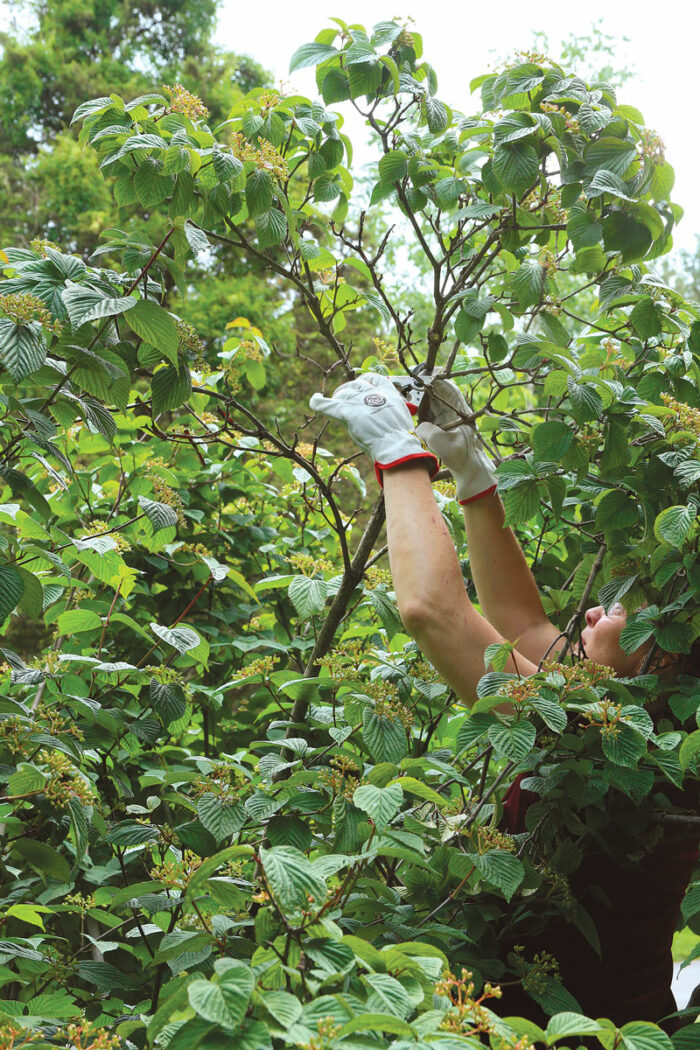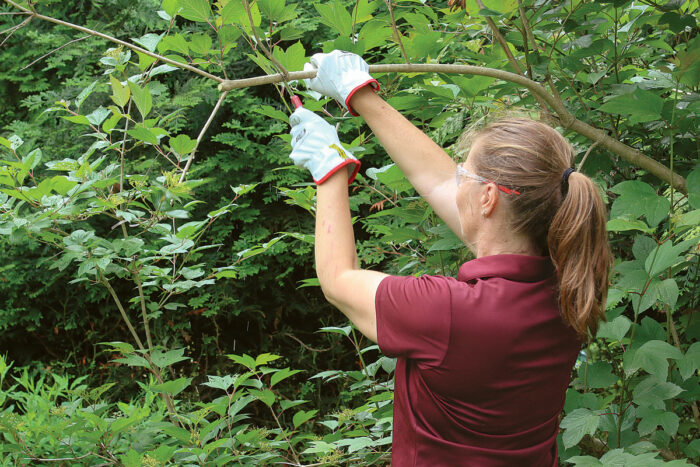
Viburnums (Viburnum spp. and cvs., Zones 2–9) are a genus of approximately 150 woody shrubs prized for their delicate, early-season flowers and bright fall fruit. Some, like smooth witherod (V. nudum, Zones 5–9), also boast charismatic fall foliage. They are lovely for adding multiseason structure to a landscape and have few insect or disease problems. They are fast-growing, with the vast majority of available cultivars able to reach a height and width of 8 feet within just a few years. Planning for their expected size is critical when siting viburnums in your landscape.
If left to its own devices, a viburnum can become a rangy, unwieldy mass that overshadows the plant’s attractive features. Nearly all species of viburnum benefit from both structural pruning that strengthens architecture, and aesthetic pruning that enhances their natural habit. No matter which species you choose from this diverse genus, thoughtful pruning techniques will preserve your viburnum for many years to come.
Your pruning strategy will depend on the plant’s age. I strongly recommend training a young plant by beginning the pruning cycle at planting time. A light pruning to eliminate obvious defects will improve the shrub’s architecture immediately. The focus is on the interior of the plant, and the goal is to create a stable framework that will help the plant withstand potentially damaging forces of nature such as wind, snow, and ice. Healthy architecture is the key to a shrub’s strength.
For more mature specimens, your pruning objectives will be different. Often, older viburnums are at risk of stem breakage due to overextended stems that are heavily weighted toward the ground. Some of these broad stems should be pruned away at the base, and others should be shortened to reduce the load at branch tips. A skilled pruner will strategize these cuts to create a shrub composed of multiple generations of branches. Removing a few older stems and allowing younger stems to thrive is a method you can use to continuously rejuvenate many multistemmed shrubs, including viburnums. For species that are prone to sending up suckers from the plant’s base, be sure to retain some of the young suckers to rejuvenate the shrub as it matures.
Viburnums can be pruned during their dormant season (late winter) and/or after they flower in late summer. All produce flower buds starting in late summer that will bloom the following spring. If live branches are removed during that window, those cuts will also remove potential flowers. If you wait to prune until just after the blooms fade, you will miss out on some colorful autumn drupes. Balance is key. If you make judicious, well-planned cuts, your pruning will work out for the greater good of the viburnum even if some of its ornamental display is sacrificed.
8 Easy Steps for Pruning Viburnums
Organize your pruning process by following these steps. Keep in mind that selective pruning is an iterative process. You may return to earlier steps in the process until you are satisfied with your pruning project.
 Step 1: Assess the state of the shrub
Step 1: Assess the state of the shrub
Walk back at least 10 feet, and circle around the viburnum to observe it from every vantage point. How is it doing overall? Is it thriving or struggling? Is there a lot of dead wood? Does it need to be pulled away from a path, a building, or another plant? How are its shape and density? By answering these questions, you’ll clarify your goals for this pruning project.
You’ll also want to identify the species and its natural habit. Most viburnums have a soft, vaselike form, but an important exception is doublefile viburnum (V. plicatum f. tomentosum, Zones 4–8), which has a distinct, tiered habit (see “Doublefile viburnum, the great exception,” below). All pruning cuts should be in concert with the plant’s natural habit.
Crouch down at the plant’s base and examine the stems where they emerge from the ground. Note any dead branches. Plan your work, starting from the base of the shrub and working through its midsection and outward to the branch tips. Keep your focus on the shrub’s interior framework.
 Step 2: Remove dead, diseased, and broken wood first
Step 2: Remove dead, diseased, and broken wood first
Take these branches out by tracing each one back to a branch union and cutting it at the branch collar. Ensure that you remove all dead branches before proceeding to the next step.

Step 3: Begin structural pruning by visualizing the viburnum from above
I think of this as “the quadrant method.” The trick is to envision the circular or oval-shaped footprint of the shrub as it would look from above and then to divide it into four sections that meet at the center. Focusing on the shrub’s base, look for stems that emerge from the ground in one quadrant but extend into a different quadrant. Consider removing these twisting stems at ground level.
Next, raise your focus to the plant’s midsection, again looking for stems that cross through the midline into another quadrant. Consider cutting these stems back to a branch union at the collar. The goal is to create a more organized, balanced canopy by reducing crossing branches.
Doublefile viburnum, the great exceptionExercise extra caution when pruning doublefile viburnums. Their natural habit is tiered, which adds a uniquely graceful, layered form to the landscape. Most of your efforts should focus on removing vertical suckers and water sprouts that interrupt the tiered branch arrangement. For this species, I recommend pruning no more than 15% to 20% of its live branches. Any hard pruning will result in the excessive production of water sprouts and suckers. |
Step 4: Step back frequently to refocus
After every few cuts, observe your viburnum from multiple vantage points at least 10 feet away, noting how your pruning has changed the shrub’s shape and density. Do any branches seem out of place? Where is there crowding? Which branches identified in step 1 have not been addressed? Plan your next cuts while standing at a distance.
 |
 |
Step 5: Focus on shape and structure
Continue pruning live wood using removal cuts at branch collars. When removing live wood, think of pruning as sculpting. If you take out a tall, vertical stem that shoots far above the rest of the canopy (above left), train yourself to remove it deep inside the shrub, back at a branch union (above right). The goal is to create a uniform but interesting shape that enhances the viburnum’s natural habit.
Step 6: Thin and shape the upper canopy
Shift your focus toward the branch tips, scouting for intertwined branches and overly dense areas. Your cuts should still primarily be made back at the branch collars, though you may use heading cuts sparingly at this stage. Remember that heading cuts stimulate growth at the leaf nodes. Step back several times during this phase of canopy pruning. As you reassess your viburnum’s evolving form, ensure that you are thinning the canopy to allow dappled sunlight to drop down into the base, stimulating new growth. Your cuts should also allow air to circulate through the branch tiers. If the base is still completely shaded, keep pruning.
Step 7: Reduce the length of overextended branches
Go back to the overall architecture of the shrub and your goal of creating a strong, open framework. Identify any overextended large branches that are likely to break under snow or ice loads. Use reduction cuts to shorten these branches. When cutting a larger-diameter branch back to a smaller-diameter branch at the collar, make sure the remaining branch is at least one-third the diameter of the larger branch being removed.
Step 8: Know when to stop
Stepping back frequently and refocusing has made every cut more efficient and purposeful, and it will ensure that you don’t go too far. Your job is done once you’ve met the goals for improving the architecture and aesthetics of your viburnum that you identified in step 1. A general rule is to prune no more than 25% of the live branches. The biggest lesson of pruning is knowing when to walk away.
Jen Kettell is an arborist and horticulturist and the owner of Radiant Leaf Consulting, a firm based in Nattik, Massachusetts, that provides training to green-industry professionals and homeowners.
Photos, except where noted: Carol Collins






















Comments
Log in or create an account to post a comment.
Sign up Log in